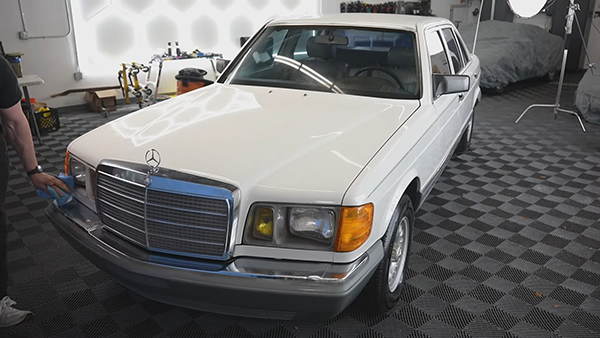If We Can Clean This ABANDONED Mercedes 380SEL, We Keep It For FREE! Today, we tackle the interior & exterior of an abandoned 1982 Mercedes 390SEL that is covered in mold, dirt and debris that hasn’t been detailed in years that will require us to pressure wash the entire exterior, followed by a wash, clay bar and then polishing the paint to bring back its shine and a full interior detail including mold removal!
If We Can Clean This ABANDONED Mercedes 380SEL, We Keep It For FREE!
There was a time when carmakers actually took to heart the time they invested in developing new cars, sometimes reaching a decade (from idea to showroom). In the seventies and eighties, Mercedes-Benz was no exception to this rule. However, being an imported luxury brand, Mercs weren’t all that popular among American buyers (at least, not compared to domestic brands. One owner even wants to give his away, but there’s a catch – the guys being offered a freebie need to get it running first.
Back in the sixties, a very vocal lawyer and activist by the name of Ralph Nader wrote ‘Unsafe at Any Speed,’ the book that is unjustly considered the axe that killed the Chevrolet Corvair. In a chain-reaction-like series of events, the book did raise enough awareness of several issues that eventually led the automotive industry to adopt profound changes.
Safety, environment, economy, efficiency – there are many topics that can be traced back to Nader’s 1965 book. Coincidentally, the seventies brought forth several major battles that scarred the American auto industry for life, eventually dethroning it from its position as the biggest car-making nation on the planet. The oil crises of 1973 and 1978 were among the most devastating blows.
The immediate effect was that import automobiles gained better traction than before, and the US market reacted accordingly. Slowly, but surely, foreign brands became more and more present in America, even though the Malaise wasn’t segregating between German, Japanese, Italian, or Detroit’s products.
Mercedes-Benz reacted quickly, and in 1979, the new Sonder Klasse (Special Class, the now-famous S-Class family) was introduced, under the code W126. With a 2.8-liter inline-six or a 3.8-liter V8, the Mercedes was incomparably outgunned by the big displacements deployed by its native rivals on the far side of the Atlantic (as seen from Stuttgart).
However, despite Mercedes’ fabled overengineering tradition, the 3.8-liter V8 that graced the 380 SEL models in 1981, when they arrived in the US, was marred by a hideous timing chain failure tendency. This is not something a buyer paying $44,300 would want to have to deal with on their new car (by comparison, a same-year Cadillac Eldorado started at a base price of just $19,400).
Also, add in that the Mercedes V8 produced 155 hp and 196 lb-ft; no wonder worldwide sales tapped out after 27,000 units (in three model years!). How many were brought to the US is quite a challenge for a detective, given the grey-market imports that were a frequent practice in the day. But we can safely assess that these luxury sedans were rare when new (no wonder, given their prohibitive prices), and downright unicorns today.

Not that they’re Gold-Rush-like desirable, but they’re still cool finds—when found. Here’s an example that the current owner got a decade or so ago and never attended to making it run. Thankfully, though, the man didn’t wait a generation or two to pass until calling for help, and he decided to clean up his property of the classic Mercedes.
Predictably, after sitting under trees for a decade, the big luxury status symbol of the early eighties is pitted with dried sap. Amazingly, that’s the worst it got – on the outside, at least. Rodents have vandalized the driver’s seat – or so it would appear, although the critters haven’t explored the entire cabin. Except for that isolated spot, the rest of the car is almost immaculate.
Still, it needs a thorough detailing, and this is where the WD Detailing team steps in—the owner of this Mercedes 380 SEL has worked with them on several occasions. The owner doesn’t know when this car last ran or drove, but the odometer reads almost 109,000 miles. The engine bay, however, is unbelievably clean for a car that has covered that much road in 33 years or less.
The detailers even try starting the engine, but the 3.8-liter V8 backfires with a loud bang, prompting the cosmeticians to leave the angry German be and call in a professional mechanic. Apparently, the problem lies in the fuel pump relay—there’s no power getting to the pump—but the detailers are determined to get it back on the road.
The owner said that he would give it to them for free if they did, and that’s enough reason not to give up on a classic German luxury automobile that may very well be driven today with no issues whatsoever. Unlike many other classics from the era, this Mercedes looks impeccable, from the tires to the roofline. It probably enjoyed life indoors when new (consider that 45,000 dollars in 1982 was a lot of money (an average house price was $82k) – it’s almost $150,000 in today’s purchasing power.
Metallurgy in the eighties was far superior to the technology standards of the sixties and seventies, and rustproofing was a lot better, too, but this example shown in the video below is squeaky clean (pun intended). What do you think? Is it still up to it as a driver (albeit occasional and not daily transportation)?